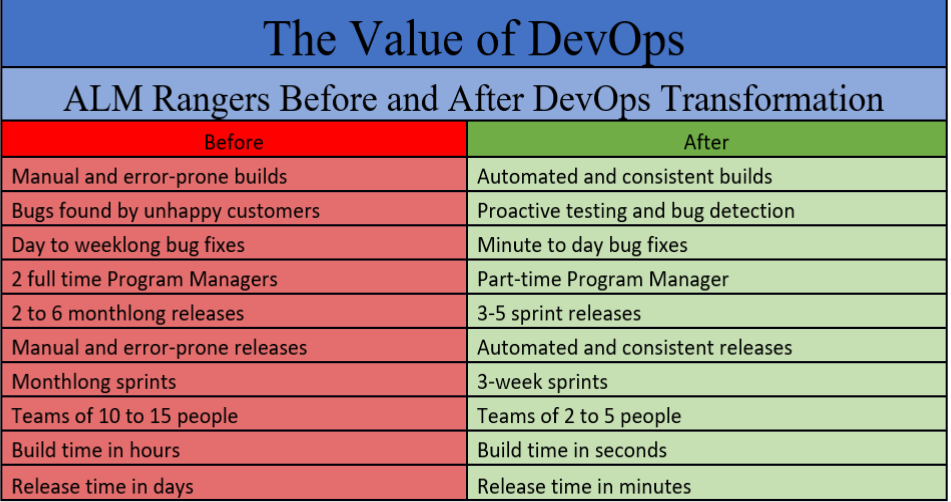mirror of
https://github.com/LCTT/TranslateProject.git
synced 2025-01-01 21:50:13 +08:00
117 lines
11 KiB
Plaintext
117 lines
11 KiB
Plaintext
# Is DevOps compatible with part-time community teams?
|
||
|
||
### DevOps can greatly benefit projects of all sizes. Here's how to build a DevOps adoption plan for smaller projects.
|
||
|
||

|
||
|
||
Image by :
|
||
|
||
[WOCinTech Chat][1]. Modified by Opensource.com. [CC BY-SA 4.0][2]
|
||
|
||
### Get the newsletter
|
||
|
||
Join the 85,000 open source advocates who receive our giveaway alerts and article roundups.
|
||
|
||
DevOps seems to be the talk of the IT world of late—and for good reason. DevOps has streamlined the process and production of IT development and operations. However, there is also an upfront cost to embracing a DevOps ideology, in terms of time, effort, knowledge, and financial investment. Larger companies may have the bandwidth, budget, and time to make the necessary changes, but is it feasible for part-time, resource-strapped communities?
|
||
|
||
Part-time communities are teams of like-minded people who take on projects outside of their normal work schedules. The members of these communities are driven by passion and a shared purpose. For instance, one such community is the [ALM | DevOps Rangers][3]. With 100 rangers engaged across the globe, a DevOps solution may seem daunting; nonetheless, they took on the challenge and embraced the ideology. Through their example, we've learned that DevOps is not only feasible but desirable in smaller teams. To read about their transformation, check out [How DevOps eliminates development bottlenecks][4].
|
||
|
||
> “DevOps is the union of people, process, and products to enable continuous delivery of value to our end customers.” - Donovan Brown
|
||
|
||
### The cost of DevOps
|
||
|
||
As stated above, there is an _upfront_ "cost" to DevOps. The cost manifests itself in many forms, such as the time and collaboration between development, operations, and other stakeholders, planning a smooth-flowing process that delivers continuous value, finding the best DevOps products, and training the team in new technologies, to name a few. This aligns directly with Donovan's definition of DevOps, in fact—a **process** for delivering **continuous value** and the **people** who make that happen.
|
||
|
||
More DevOps resources
|
||
|
||
* [What is DevOps?][5]
|
||
* [Free eBook: DevOps with OpenShift][6]
|
||
* [10 bad DevOps habits to break][7]
|
||
* [10 must-read DevOps resources][8]
|
||
* [The latest on DevOps][9]
|
||
|
||
Streamlined DevOps takes a lot of planning and training just to create the process, and that doesn't even consider the testing phase. We also can't forget the existing in-flight projects that need to be converted into the new system. While the cost increases the more pervasive the transformation—for instance, if an organization aims to unify its entire development organization under a single process, then that would cost more versus transforming a single pilot or subset of the entire portfolio—these upfront costs must be addressed regardless of their scale. There are a lot of resources and products already out there that can be implemented for a smoother transition—but again, we face the time and effort that will be necessary just to research which ones might work best.
|
||
|
||
In the case of the ALM | DevOps Rangers, they had to halt all projects for a couple of sprints to set up the initial process. Many organizations would not be able to do that. Even part-time groups might have very good reasons to keep things moving, which only adds to the complexity. In such scenarios, additional cutover planning (and therefore additional cost) is needed, and the overall state of the community is one of flux and change, which adds risk, which—you guessed it—requires more cost to mitigate.
|
||
|
||
There is also an _ongoing_ "cost" that teams will face with a DevOps mindset: Simple maintenance of the system, training and transitioning new team members, and keeping up with new, improved technologies are all a part of the process.
|
||
|
||
### DevOps for a part-time community
|
||
|
||
Whereas larger companies can dedicate a single manager or even a team to the task over overseeing the continuous integration and continuous deployment (CI/CD) pipelines, part-time community teams don't have the bandwidth to give. With such a massive undertaking we must ask: Is it even worth it for groups with fewer resources to take on DevOps for their community? Or should they abandon the idea of DevOps altogether?
|
||
|
||
The answer to that is dependent on a few variables, such as the ability of the teams to be self-managing, the time and effort each member is willing to put into the transformation, and the dedication of the community to the process.
|
||
|
||
### Example: Benefits of DevOps in a part-time community
|
||
|
||
Luckily, we aren't without examples to demonstrate just how DevOps can benefit a smaller group. Let's take a quick look at the ALM Rangers again. The results from their transformation help us understand how DevOps changed their community:
|
||
|
||

|
||
|
||
As illustrated, there are some huge benefits for part-time community teams. Planning goes from long, arduous design sessions to a quick prototyping and storyboarding process. Builds become automated, reliable, and resilient. Testing and bug detection are proactive instead of reactive, which turns into a happier clientele. Multiple full-time program managers are replaced with self-managing teams with a single part-time manager to oversee projects. Teams become smaller and more efficient, which equates to higher production rates and higher-quality project delivery. With results like these, it's hard to argue against DevOps.
|
||
|
||
Still, the upfront and ongoing costs aren't right for every community. The number-one most important aspect of any DevOps transformation is the mindset of the people involved. Adopting the idea of self-managing teams who work in autonomy instead of the traditional chain-of-command scheme can be a challenge for any group. The members must be willing to work independently without a lot of oversight and take ownership of their features and user experience, but at the same time, work in a setting that is fully transparent to the rest of the community. **The success or failure of a DevOps strategy lies on the team.**
|
||
|
||
### Making the DevOps transition in 4 steps
|
||
|
||
Another important question to ask: How can a low-bandwidth group make such a massive transition? The good news is that a DevOps transformation doesn’t need to happen all at once. Taken in smaller, more manageable steps, organizations of any size can embrace DevOps.
|
||
|
||
1. Determine why DevOps may be the solution you need. Are your projects bottlenecking? Are they running over budget and over time? Of course, these concerns are common for any community, big or small. Answering these questions leads us to step two:
|
||
2. Develop the right framework to improve the engineering process. DevOps is all about automation, collaboration, and streamlining. Rather than trying to fit everyone into the same process box, the framework should support the work habits, preferences, and delivery needs of the community. Some broad standards should be established (for example, that all teams use a particular version control system). Beyond that, however, let the teams decide their own best process.
|
||
3. Use the current products that are already available if they meet your needs. Why reinvent the wheel?
|
||
4. Finally, implement and test the actual DevOps solution. This is, of course, where the actual value of DevOps is realized. There will likely be a few issues and some heartburn, but it will all be worth it in the end because, once established, the products of the community’s work will be nimbler and faster for the users.
|
||
|
||
### Reuse DevOps solutions
|
||
|
||
One benefit to creating effective CI/CD pipelines is the reusability of those pipelines. Although there is no one-size fits all solution, anyone can adopt a process. There are several pre-made templates available for you to examine, such as build templates on VSTS, ARM templates to deploy Azure resources, and "cookbook"-style textbooks from technical publishers. Once it identifies a process that works well, a community can also create its own template by defining and establishing standards and making that template easily discoverable by the entire community. For more information on DevOps journeys and tools, check out [this site][10].
|
||
|
||
### Summary
|
||
|
||
Overall, the success or failure of DevOps relies on the culture of a community. It doesn't matter if the community is a large, resource-rich enterprise or a small, resource-sparse, part-time group. DevOps will still bring solid benefits. The difference is in the approach for adoption and the scale of that adoption. There are both upfront and ongoing costs, but the value greatly outweighs those costs. Communities can use any of the powerful tools available today for their pipelines, and they can also leverage reusability, such as templates, to reduce upfront implementation costs. DevOps is most certainly feasible—and even critical—for the success of part-time community teams.
|
||
|
||
---
|
||
|
||
**\[See our related story, [How DevOps eliminates development bottlenecks][11].\]**
|
||
|
||
|
||
### About the author
|
||
|
||
[][13]
|
||
|
||
Edward Fry \- Edward a business technophile who revels in blending people, process, and technology to solve real problems with grace and efficiency. As a member of the ALM Rangers, he loves to share his passion for the process of software development and ways to get computers to do the drudge work so that people can dream the big dreams. He also enjoys the art of great software design and architecture and also just likes being immersed in code. When he isn't helping people with technology, he enjoys... [more about Edward Fry][14]
|
||
|
||
[More about me][15]
|
||
|
||
* [Learn how you can contribute][16]
|
||
|
||
---
|
||
|
||
via: [https://opensource.com/article/18/4/devops-compatible-part-time-community-teams][17]
|
||
|
||
作者: [Edward Fry][18] 选题者: [@lujun9972][19] 译者: [译者ID][20] 校对: [校对者ID][21]
|
||
|
||
本文由 [LCTT][22] 原创编译,[Linux中国][23] 荣誉推出
|
||
|
||
[1]: https://www.flickr.com/photos/wocintechchat/25392377053/
|
||
[2]: https://creativecommons.org/licenses/by/4.0/
|
||
[3]: https://github.com/ALM-Rangers
|
||
[4]: https://opensource.com/article/17/11/devops-rangers-transformation
|
||
[5]: https://opensource.com/resources/devops?src=devops_resource_menu1
|
||
[6]: https://www.openshift.com/promotions/devops-with-openshift.html?intcmp=7016000000127cYAAQ&src=devops_resource_menu2
|
||
[7]: https://enterprisersproject.com/article/2018/1/10-bad-devops-habits-break?intcmp=7016000000127cYAAQ&src=devops_resource_menu3
|
||
[8]: https://opensource.com/article/17/12/10-must-read-devops-books?src=devops_resource_menu4
|
||
[9]: https://opensource.com/tags/devops?src=devops_resource_menu5
|
||
[10]: https://www.visualstudio.com/devops/
|
||
[11]: https://opensource.com/article/17/11/devops-rangers-transformation
|
||
[12]: https://opensource.com/tags/devops
|
||
[13]: https://opensource.com/users/edwardf
|
||
[14]: https://opensource.com/users/edwardf
|
||
[15]: https://opensource.com/users/edwardf
|
||
[16]: https://opensource.com/participate
|
||
[17]: https://opensource.com/article/18/4/devops-compatible-part-time-community-teams
|
||
[18]: https://opensource.com/users/edwardf
|
||
[19]: https://github.com/lujun9972
|
||
[20]: https://github.com/译者ID
|
||
[21]: https://github.com/校对者ID
|
||
[22]: https://github.com/LCTT/TranslateProject
|
||
[23]: https://linux.cn/ |